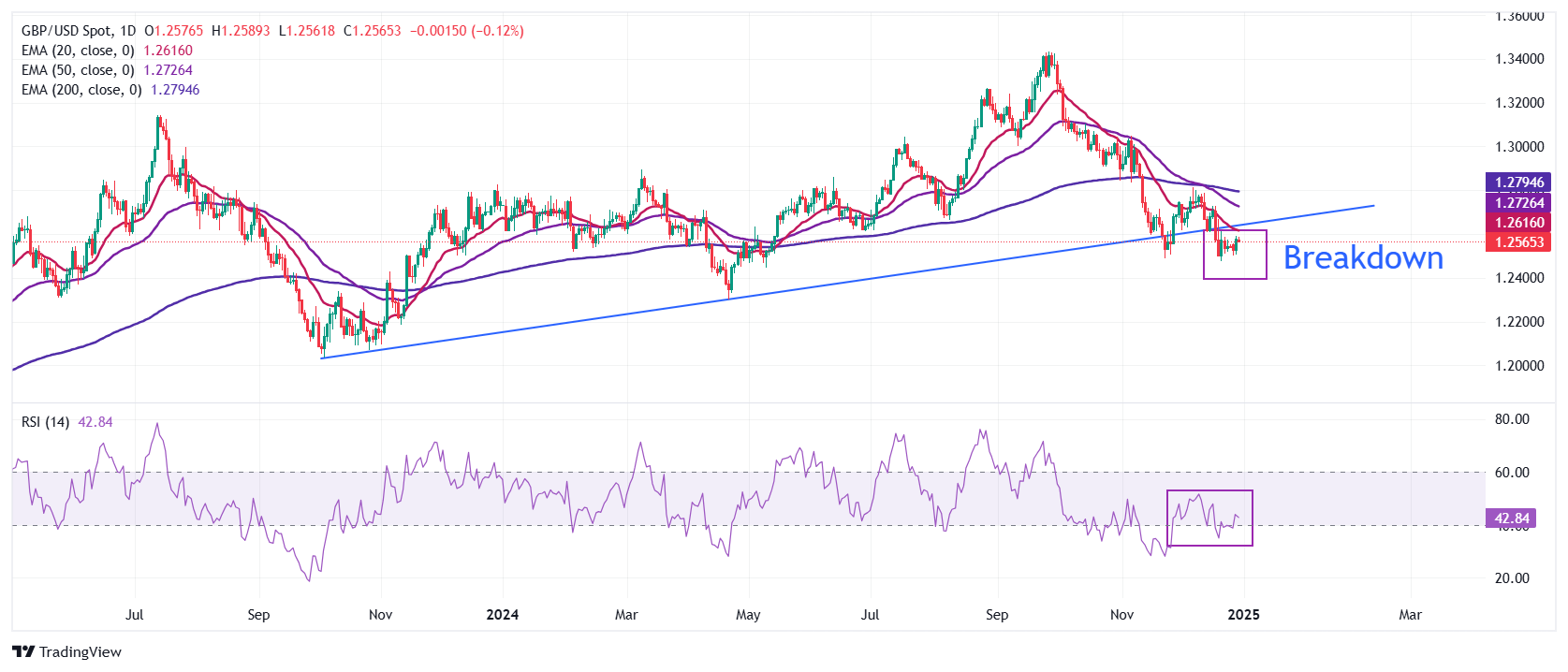- The Pound Sterling falls back against the US Dollar as the latter rebounds.
- Goldman Sachs sees the BoE reducing interest rates in each quarter of the next year.
- The US Dollar flattens in illiquid trading conditions before New Year celebrations.
The Pound Sterling (GBP) drops to near 1.2550 after failing to extend the intraday high of 1.2600 and turns negative against the US Dollar (USD) in Monday's North American session. The GBP/USD pair falls as the US Dollar (USD) bounces back in thin trading volume conditions before New Year celebrations. The US Dollar Index (DXY), which tracks the Greenback’s value against six major currencies, rises to near 108.30 and is set to end the year with almost 6.7% gains.
The USD performed strongly this year even though the Federal Reserve (Fed) reduced its key borrowing rates by 100 basis points (bps) to 4.25%-4.50%. The Greenback has gained significantly in the last three months after Republican Donald Trump’s victory in the United States (US) Presidential election as policies such as immigration control, higher import tariffs, and lower taxes are expected to be inflationary and pro-growth.
The Fed has also signaled fewer interest rate cuts in 2025 amid strong economic growth prospects, a slowdown in the disinflation trend, and better labor market conditions than previously forecasted. However, Fed Chair Jerome Powell refrained from guiding the likely impact of Trump’s policies on the economy.
"It is very premature to make any kind of conclusions,” Powell said on December 18. “We don’t know what will be tariffed, from what countries, for how long, in what size," he added.
This week, the major trigger for the Pound Sterling and the US Dollar will be the final estimates for the December S&P Global and US ISM Manufacturing Purchasing Managers’ Index (PMI) data
Pound Sterling drops as market experts see more interest rate cuts by the BoE in 2025 compared to market pricing
- The Pound Sterling faces pressure against its major peers on Monday. The British currency drops amid a mild increase in the Bank of England's (BoE) dovish bets for 2025.
- Traders price in a 53-basis points (bps) interest rate reduction for the next year, up from the 46 bps estimated after the policy announcement on December 19, when the Bank of England (BoE) left borrowing rates unchanged at 4.75% with a 6-3 vote split. Before the policy announcement, market participants were anticipating that only one Monetary Policy Committee (MPC) would vote for a rate cut.
- The BoE has been the slowest among European and North American nations to reduce interest rates this year. The BoE has reduced its key borrowing rates by 50 bps, while other peers such as the Federal Reserve (Fed) and the European Central Bank (ECB) pushed their borrowing rates lower by 100 bps. The Bank of Canada (BoC) and the Swiss National Bank (SNB) lowered interest rates by even more due to higher risks of inflation undershooting their respective targets.
- "UK wage growth and services inflation have remained notably stickier than elsewhere, despite signs of material labor market rebalancing,” analysts at Goldman Sachs said in a note. “As a result, the BoE has been more cautious than other major central banks," they added. However, the investment banking firm expects continued quarterly cuts through 2025, more than what markets expect, as a “weaker labor market cools underlying inflation.”
British Pound PRICE Today
The table below shows the percentage change of British Pound (GBP) against listed major currencies today. British Pound was the strongest against the Swiss Franc.
| USD | EUR | GBP | JPY | CAD | AUD | NZD | CHF | |
|---|---|---|---|---|---|---|---|---|
| USD | 0.35% | 0.20% | -0.20% | -0.07% | 0.04% | -0.19% | 0.47% | |
| EUR | -0.35% | -0.13% | -0.59% | -0.46% | -0.38% | -0.59% | 0.07% | |
| GBP | -0.20% | 0.13% | -0.42% | -0.30% | -0.25% | -0.44% | 0.21% | |
| JPY | 0.20% | 0.59% | 0.42% | 0.10% | 0.29% | 0.16% | 0.70% | |
| CAD | 0.07% | 0.46% | 0.30% | -0.10% | 0.10% | -0.06% | 0.53% | |
| AUD | -0.04% | 0.38% | 0.25% | -0.29% | -0.10% | -0.20% | 0.46% | |
| NZD | 0.19% | 0.59% | 0.44% | -0.16% | 0.06% | 0.20% | 0.66% | |
| CHF | -0.47% | -0.07% | -0.21% | -0.70% | -0.53% | -0.46% | -0.66% |
The heat map shows percentage changes of major currencies against each other. The base currency is picked from the left column, while the quote currency is picked from the top row. For example, if you pick the British Pound from the left column and move along the horizontal line to the US Dollar, the percentage change displayed in the box will represent GBP (base)/USD (quote).
Technical Analysis: Pound Sterling faces pressure near 1.2600
The Pound Sterling trades broadly sideways against the US Dollar below 1.2600 on Monday. The outlook of the GBP/USD pair remains vulnerable as it trades below the upward-sloping trendline around 1.2600, which is plotted from the October 2023 low of 1.2035.
All short-to-long-term Exponential Moving Averages (EMAs) are sloping down, suggesting a strong bearish trend in the long run.
The 14-day Relative Strength Index (RSI) hovers around 40.00. A fresh downside momentum could trigger if the oscillator sustains below this level.
Looking down, the pair is expected to find a cushion near the April 22 low at around 1.2300 if it breaks below the immediate support of 1.2485. On the upside, the December 17 high at 1.2730 will act as key resistance.
BoE FAQs
The Bank of England (BoE) decides monetary policy for the United Kingdom. Its primary goal is to achieve ‘price stability’, or a steady inflation rate of 2%. Its tool for achieving this is via the adjustment of base lending rates. The BoE sets the rate at which it lends to commercial banks and banks lend to each other, determining the level of interest rates in the economy overall. This also impacts the value of the Pound Sterling (GBP).
When inflation is above the Bank of England’s target it responds by raising interest rates, making it more expensive for people and businesses to access credit. This is positive for the Pound Sterling because higher interest rates make the UK a more attractive place for global investors to park their money. When inflation falls below target, it is a sign economic growth is slowing, and the BoE will consider lowering interest rates to cheapen credit in the hope businesses will borrow to invest in growth-generating projects – a negative for the Pound Sterling.
In extreme situations, the Bank of England can enact a policy called Quantitative Easing (QE). QE is the process by which the BoE substantially increases the flow of credit in a stuck financial system. QE is a last resort policy when lowering interest rates will not achieve the necessary result. The process of QE involves the BoE printing money to buy assets – usually government or AAA-rated corporate bonds – from banks and other financial institutions. QE usually results in a weaker Pound Sterling.
Quantitative tightening (QT) is the reverse of QE, enacted when the economy is strengthening and inflation starts rising. Whilst in QE the Bank of England (BoE) purchases government and corporate bonds from financial institutions to encourage them to lend; in QT, the BoE stops buying more bonds, and stops reinvesting the principal maturing on the bonds it already holds. It is usually positive for the Pound Sterling.
Information on these pages contains forward-looking statements that involve risks and uncertainties. Markets and instruments profiled on this page are for informational purposes only and should not in any way come across as a recommendation to buy or sell in these assets. You should do your own thorough research before making any investment decisions. FXStreet does not in any way guarantee that this information is free from mistakes, errors, or material misstatements. It also does not guarantee that this information is of a timely nature. Investing in Open Markets involves a great deal of risk, including the loss of all or a portion of your investment, as well as emotional distress. All risks, losses and costs associated with investing, including total loss of principal, are your responsibility. The views and opinions expressed in this article are those of the authors and do not necessarily reflect the official policy or position of FXStreet nor its advertisers. The author will not be held responsible for information that is found at the end of links posted on this page.
If not otherwise explicitly mentioned in the body of the article, at the time of writing, the author has no position in any stock mentioned in this article and no business relationship with any company mentioned. The author has not received compensation for writing this article, other than from FXStreet.
FXStreet and the author do not provide personalized recommendations. The author makes no representations as to the accuracy, completeness, or suitability of this information. FXStreet and the author will not be liable for any errors, omissions or any losses, injuries or damages arising from this information and its display or use. Errors and omissions excepted.
The author and FXStreet are not registered investment advisors and nothing in this article is intended to be investment advice.
Recommended content
Editors’ Picks

EUR/USD extends slide toward 1.0300, touches new two-year low
EUR/USD stays under bearish pressure and trades at its lowest level since December 2022 below 1.0350 on Thursday. The pair turned south amid a resurgent US Dollar demand and worsening market mood. Investors stay cautious at the onset of 2025, awaiting the US jobs data for fresh incentives.

GBP/USD slumps to multi-month lows below 1.2450
Following an earlier recovery attempt, GBP/USD reversed its direction and declined to its weakest level in nearly eight months below 1.2450. The renewed US Dollar (USD) strength on worsening risk mood weighs on the pair as markets await mid-tier data releases.

Gold benefits from risk aversion, climbs above $2,640
Gold gathers recovery momentum and trades at a two-week-high above $2,640 heading into the American session on Thursday. The precious metal benefits from the sour market mood and the pullback seen in the US Treasury bond yields.

XRP rockets 11% as Bitcoin starts New Year with bullish bang
Crypto majors zoomed higher in the past 24 hours as the market entered a widely expected bullish year, with Bitcoin inching above $95,000 to shake off losses from last week. XRP surged 11% to lead growth among majors as of Thursday, led by $1.3 billion worth of trading volumes on Korea-focused exchange UpBit.

Three Fundamentals: Year-end flows, Jobless Claims and ISM Manufacturing PMI stand out Premium
Money managers may adjust their portfolios ahead of the year-end. Weekly US Jobless Claims serve as the first meaningful release in 2025. The ISM Manufacturing PMI provides an initial indication ahead of Nonfarm Payrolls.

Best Forex Brokers with Low Spreads
VERIFIED Low spreads are crucial for reducing trading costs. Explore top Forex brokers offering competitive spreads and high leverage. Compare options for EUR/USD, GBP/USD, USD/JPY, and Gold.
